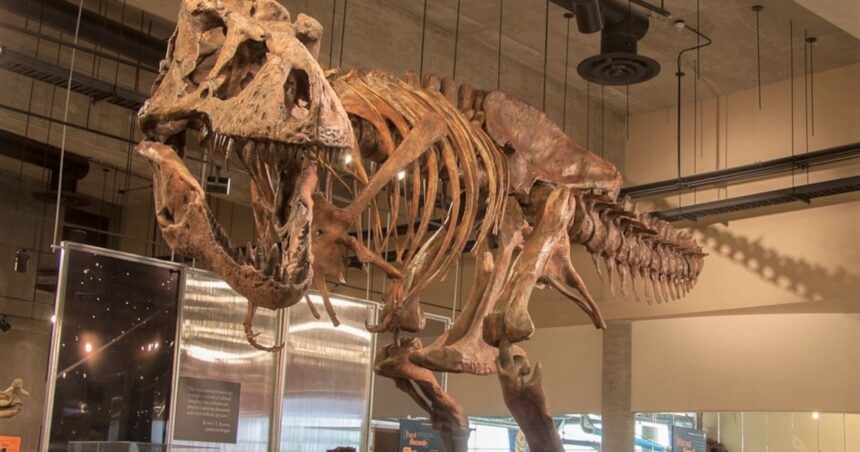In the badlands of southern Saskatchewan, where prairie grasses give way to ancient sediments, a remarkable discovery is breathing new life into our understanding of prehistoric creatures. Researchers working with “Scotty,” Saskatchewan’s most famous Tyrannosaurus rex fossil, have identified preserved blood vessels that survived 66 million years—a finding that’s sending ripples through the scientific community.
“What we’ve found challenges our assumptions about fossilization,” explains Dr. Emily Lakeman, lead paleontologist at the Royal Saskatchewan Museum. “These aren’t just bones—they’re time capsules with biological material we never expected to survive.”
The discovery occurred during routine conservation work when technicians noticed unusual fibrous structures within a femur fragment. Further analysis confirmed these were blood vessels, preserved through a process called molecular preservation, where iron minerals effectively “pickled” the organic structures before they could fully decompose.
This isn’t the first time soft tissues have been found in dinosaur remains, but it’s among the most well-preserved examples, and certainly the most significant find in Canadian paleontology in recent years.
“Saskatchewan has always been fossil country,” says Robert Hildebrand, a veteran fossil hunter who assisted with Scotty’s original excavation near Eastend in 1991. “But finding biological material that’s survived tens of millions of years? That’s hitting the scientific jackpot.”
The preserved vessels are providing unprecedented insights into dinosaur physiology. Preliminary analysis suggests T. rex had a cardiovascular system more similar to modern birds than reptiles—adding evidence to the evolutionary link between dinosaurs and their avian descendants.
For Melanie Whitaker, curator at the T.rex Discovery Centre in Eastend, the findings bring new significance to a fossil that already attracts thousands of visitors annually. “Scotty was already special as one of the largest and most complete T. rex specimens ever found. Now he’s teaching us about dinosaur biology in ways we never imagined possible.”
The preservation quality has allowed researchers to extract proteins and other biomolecules that reveal details about Scotty’s diet, metabolism, and even potential diseases. Scientists have identified markers suggesting this particular dinosaur suffered from a form of osteomyelitis, a bone infection that likely caused considerable pain during its final years.
“We’re literally looking at a dinosaur’s medical history,” notes Dr. Lakeman. “That’s something paleontologists could only dream about a generation ago.”
The Saskatchewan government has announced additional funding for the research program, recognizing both the scientific importance and tourism potential. Minister of Parks Greg Ottenbreit called the discovery “a proud moment for Saskatchewan that puts our province at the forefront of paleontological research.”
Local communities are already feeling the impact. Hotels in Eastend report increased bookings as news of the discovery spreads, and school trip requests to the Discovery Centre have doubled compared to last summer.
“Kids are fascinated by dinosaurs already,” says elementary school teacher Janet Morrissey from Regina. “But when they hear scientists are finding actual blood vessels from a T. rex that lived right here in Saskatchewan, that connection to science becomes personal and powerful.”
The research team is using advanced imaging techniques and molecular analysis tools developed for medical research to study the preserved vessels. This cross-disciplinary approach has created unexpected collaboration between paleontologists and medical researchers from the University of Saskatchewan.
“The techniques we use to study modern vascular systems work surprisingly well on 66-million-year-old blood vessels,” explains Dr. Thomas Chen, a vascular biologist consulting on the project. “The preservation is remarkable—we can see cellular structures that tell us about blood flow, tissue elasticity, and other physiological details.”
Public interest in the findings has prompted the Royal Saskatchewan Museum to develop a special exhibition scheduled to open this fall, featuring interactive displays explaining how soft tissue preservation occurs and what it teaches us about dinosaur biology.
“This isn’t just about dinosaurs,” says Dr. Lakeman. “It’s about understanding how life worked on our planet across vast timescales. Every blood vessel we analyze is like reading another page from an ancient biological textbook.”
For Saskatchewan residents, the discovery adds a new dimension to provincial pride. “First we had wheat, then potash, now dinosaur blood vessels,” jokes Frank Pelletier, a local farmer who volunteers at fossil digs. “Saskatchewan keeps finding ways to matter.”
As analysis continues, researchers hope to extract DNA fragments, though they caution that complete genomic recovery—as portrayed in popular movies—remains highly unlikely. Still, the preserved biomolecules offer unprecedented glimpses into dinosaur genetics.
The findings have been published in the journal Nature, with follow-up studies already underway. Researchers from institutions in the United States, United Kingdom and China have requested samples for comparative analysis with similar discoveries elsewhere.
“Science is collaborative,” Dr. Lakeman emphasizes. “What we learn from Scotty will help researchers studying other fossils around the world, just as their work helps us understand what we’ve found here.”
For now, Scotty’s blood vessels remain safely preserved in laboratory conditions as research continues—a remarkable biological time capsule from the ancient prairies of Saskatchewan, offering new insights into the lives of the remarkable creatures that once called this land home.






